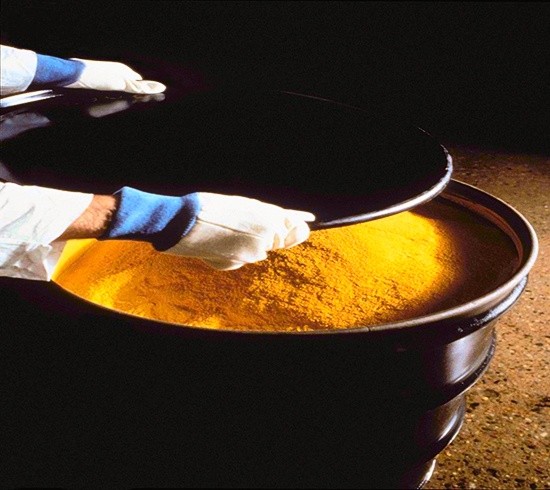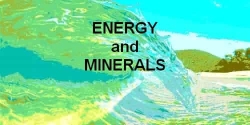Australian Uranium Deposits
Australian Uranium Deposits
Adapted to HTML from Nuclear Issues Briefing Paper # 34by permission to Earth Science Australia from the Uranium Information Centre Ltd.
Australia's Uranium Orebodies
Unconformity-related deposits
Breccia complex deposits
Sandstone deposits
Surficial deposits
Volcanic deposits
Intrusive deposits
Metasomatite deposits
Vein deposits
Uranium Minerals
Sources
see also Insitu Uranium Leach Mining

Uranium occurs in a number of different igneous, hydrothermal and sedimentary geological environments.
Australia's Uranium Orebodies
Most of Australia's uranium resources are in two kinds of orebodies, unconformity-related and breccia complex, while sedimentary deposits are less significant than overseas.Uranium deposits world-wide can be grouped into 14 major categories of deposit types based on the geological setting of the deposits (OECD/NEA & IAEA, 1996).
Australian uranium deposits can be grouped into 6 of these categories, with some mineralisation in two further ones

Unconformity-related deposits -
Unconformity-related deposits arise from geological changes occurring close to major unconformities. Below the unconformity, the metasedimentary rocks which host the mineralisation are usually faulted and brecciated. The overlying younger Proterozoic sandstones are usually undeformed.Unconformity-related deposits constitute approximately 33% of the World Outside Centrally Planned Economies Area (WOCA)'s uranium resources and they include some of the largest and richest deposits. Minerals are uraninite and pitchblende. The main deposits occur in Canada (the Athabasca Basin, Saskatchewan and Thelon Basin, Northwest Territories); and Australia (the Alligator Rivers region in the Pine Creek Geosyncline, NT and Rudall River area, WA). Unconformity-related deposits- constitute a major proportion (22%) of Australia's total uranium resources and more than 80% of Australia's total production since 1980 has been mined from two of these deposits - Ranger #1 and Nabarlek (now mined out). Other major deposits in the Alligator Rivers region are Ranger # 3, Jabiluka (North Ranger), Koongarra and Ranger 68.
In 1996, more than 95% of Canada's total uranium production was from unconformity-related deposits - Key Lake, Cluff Lake, and Rabbit Lake deposits. Other large, exceptionally high grade unconformity-related deposits which are being developed for future mining include Cigar Lake (averaging 9.1% U3O8, some zones over 50% U3O8); McArthur River (averaging 5.0% U3O8, some zones average 42% U3O8); Eagle Point, Collins Bay A and D orebodies and McClean Lake.
The deposits in the Athabasca Basin occur below, across and immediately above the unconformity, with the highest grade deposits situated above (eg Cigar Lake) and across the unconformity (eg Key Lake).
In the Alligator Rivers region, the known deposits are below the unconformity and are generally much lower grade than the Canadian deposits. Uranium exploration in the Alligator Rivers region and Arnhem Land has been restricted since the late 1970s because of political and environmental factors. Much of the Alligator Rivers region and Arnhem Land have only been subjected to first pass exploration designed to detect outcropping deposits and extensions of known deposits, eg Jabiluka 2 was found by drilling along strike from Jabiluka 1. There has been very little exploration to locate deeply concealed deposits lying above the unconformity similar to those in Canada. It is possible that very high grade deposits occur in the sandstones above the unconformity in the Alligator Rivers/Arnhem Land area.
The Kintyre deposit in the Rudall River area is similar to the deposits in the Alligator Rivers region. Metallurgical tests have shown that Kintyre ore can be radiometrically sorted and upgraded prior to milling and processing.
Breccia complex deposits -
The Olympic Dam deposit is one of the world's largest deposits ofuranium, and accounts for about 66% of Australiaís reserves plus resources. The deposit occurs in a hematite-rich granite breccia complex in the Gawler Craton. It is overlain by approximately 300 metres of flat-lying sedimentary rocks of the Stuart Shelf geological province.The central core of the complex is barren hematite-quartz breccia, with several localised diatreme structures, flanked to the east and west by zones of intermingled hematite-rich breccias and granitic breccias. These zones are approximately one kilometre wide and extend almost 5 km in a northwest-southeast direction. Virtually all the economic copper-uranium mineralisation is hosted by these hematite-rich breccias. This broad zone is surrounded by granitic breccias extending up to 3 km beyond the outer limits of the hematite-rich breccias.
The deposit contains iron, copper, uranium, gold, silver, rare earth elements (mainly lanthanum and cerium) and fluorine. Only copper, uranium, gold, and silver are recovered. Uranium grades average from 0.08 to 0.04% U3O8, the higher-grade mineralisation being pitchblende. Copper grades average 2.7% for proved reserves, 2.0% for probable reserves, and 1.1% for indicated resources. Gold grades vary between 0.3-1.0 g/t.
Details of the origin of the deposit are still uncertain. However the principal mechanisms whichformed the breccia complex are considered to have been hydraulic fracturing, tectonic faulting, chemical corrosion, and gravity collapse. Much of the brecciation occurred in near surface eruptive environment of a crater complex during eruptions caused by boiling and explosive interaction of water (from lake, sea or groundwater) with magma.
Sandstone Deposits
Sandstone uranium deposits occur in medium to coarse-grained sandstones deposited in a continental fluvial or marginal marine sedimentary environment. Impermeable shale/mudstone units are interbedded in the sedimentary sequence and often occur immediately above and below the mineralised sandstone. Uranium precipitated under reducing conditions caused by a variety of reducing agents within the sandstone including: carbonaceous material (detrital plant debris, amorphous humate, marine algae), sulphides (pyrite, H2S), hydrocarbons (petroleum), and interbedded basic volcanics with abundant ferro-magnesian minerals (eg chlorite).Three main types of sandstone deposits: rollfront deposits - arcuate bodies of mineralisation that crosscut sandstone bedding;
tabular deposits - irregular, elongate lenticular bodies parallel to the depositional trend, deposits commonly occur in palaeochannels incised into underlying basement rocks;
tectonic/lithologic deposits - occur in sandstones adjacent to a permeable fault zone.
Sandstone deposits constitute about 18% of world uranium resources. Orebodies of this type arecommonly low to medium grade (0.05 - 0.4% U3O8) and individual orebodies are small to medium in size (ranging up to a maximum of 50 000 t U3O8). The main primary uranium minerals are uraninite and coffinite. Conventional mining/milling operations of sandstone deposits have been progressively undercut by cheaper in situ leach mining methods.
The United States has large resources in sandstone deposits in the Western Cordillera region, and most of its uranium productionin has been from these deposits. Uranium is being recovered from in situ leach mining of sandstone deposits in the South Texas area (Texas Gulf Coast).
Large uranium resources within sandstone deposits also occur in Niger, Kazakstan, Uzbekistan, Gabon (Franceville Basin), and South Africa (Karoo Basin). Kazakstan has reported substantial reserves in sandstone deposits with average grades ranging from 0.02 to 0.07% U. In 1994, approximately 75% of Uzbekistan's uranium production and 70% of Kazakstan's production was from in situ leach mining of sandstone deposits.
Sandstone deposits represent only about 6% of Australia's total reserves plus resources of uranium .In the Westmoreland area, northwest Queensland, the bulk of the resources are within five ore lenses in sandstones along the flanks of the Redtree joint zone. The mineralised sandstone is overlain by basic volcanics.
Within the Frome Embayment, six uranium deposits are known, the largest being Beverley and Honeymoon. Tests have shown that these two deposits are amenable to in situ leach mining methods. At the Mulga Rock deposit, 230 km east-northeast of Kalgoorlie, uranium mineralisation is in peat layers interbedded with sand and clay within a buried palaeochannel.
Quartz-pebble conglomerate deposits -
these deposits make up approximately 13% of theworld's uranium resources. Where uranium is recovered as a by-product of gold mining, the grade may be as low as 0.01% U3O8. In deposits mined exclusively for uranium, average grades range as high as 0.15% U3O8. Individual deposits range in size from 6000-170 000 t contained U3O8.Major examples are the Elliot Lake deposits in Canada and the Witwatersrand gold-uranium deposits in South Africa. Mining operations in the Elliot Lake area have closed in recent years because these deposits are uneconomic under current uranium market conditions.
No such economic deposits are known in Australia, although quartz-pebble conglomerate containing low-grade uraninite mineralisation exists in several Archaean-Palaeoproterozoic basins in Western Australia. These are similar in lithology and age to the Witwatersrand conglomerates.
Surficial deposits -
Surficial uranium deposits are broadly defined as young (Tertiary to Recent)near-surface uranium concentrations in sediments or soils. These deposits usually have secondarycementing minerals including calcite, gypsum, dolomite, ferric oxide, and halite. Uranium deposits in calcrete are the largest of the surficial deposits. Uranium mineralisation is in fine-grained surficial sand and clay, cemented by calcium and magnesium carbonates. Surficial uranium deposits also occur in peat, bog, karst caverns and soils.
Surficial deposits comprise approximately 4% of world uranium resources. Calcrete depositsrepresent 4% of Australia's total reserves and resources of uranium. The Yeelirrie deposit in WA is by far the world's largest surficial deposit. Other significant deposits in WA include Lake Way, Centipede, Thatcher Soak, and Lake Maitland.
In WA, the calcrete uranium deposits occur in valley-fill sediments along Tertiary drainage channels, and in playa lake sediments. These deposits overlie Archaean granite and greenstone basement of the northern portion of the Yilgarn Craton. The uranium mineralisation is carnotite (hydrated potassium uranium vanadium oxide).
Calcrete uranium deposits also occur in the Central Namib Desert of Namibia.
Volcanic deposits-
uranium deposits of this type occur in acid volcanic rocks and are related tofaults and shear zones within the volcanics. Uranium is commonly associated with molybdenum and fluorine. These deposits make up only a small proportion of the world's uranium resources. Significant resources of this type occur in China, Kazakstan, Russian Federation and Mexico. In Australia, volcanic deposits are quantitatively very minor - Ben Lomond and Maureen are the most significant deposits.Intrusive deposits -
included in this type are those associated with intrusive rocks includingalaskite, granite, pegmatite, and monzonites. Major world deposits include Rossing (Namibia), Ilimaussaq (Greenland) and Palabora (South Africa). In Australia, the only significant deposits are the large bodies of low grade mineralisation at Crocker Well and Mount Victoria in the Olary Province, SA.Metasomatite deposits
- these occur in structurally-deformed rocks that were already altered bymetasomatic processes, usually associated with the introduction of sodium, potassium or calcium into these rocks. Major examples of this type include Espinharas deposit (Brazil) and the Zheltye Vody deposit (Ukraine).In Australia the largest of this type was Mary Kathleen uranium/rare earth deposit, 60km east of Mount Isa, Qld, which was mined 1958-63 and 1976-82. The orebody occurs in a zone of calcium-rich alteration within Proterozoic metamorphic rocks.
Vein deposits
- Vein deposits constitute about 9% of world uranium resources. Major deposits include Jachymov (Czech Republic) and Shinkolobwe (Zaire). The largest vein deposit in Australia was Radium Hill (SA) which was mined from 1954-62. Mineralisation was mostly davidite.Uranium Minerals

The major primary ore mineral is uraninite or pitchblende (UO2 + UO3, nominally U3O8), though a range of other uranium minerals is found in particular deposits. These include carnotite (uranium potassium vanadate), the davidite-brannerite-absite type uranium titanates, and the euxenite-fergusonite-samarskite group (niobates of uranium and rare earths).
A large variety of secondary uranium minerals is known, many are brilliantly coloured and fluorescent. The commonest are gummite (a general term like limonite for mixtures of various secondary hydrated uraniuim oxides with impurities); hydrated uranium phosphates of the phosphuranylite type, including autunite (with calcium), saleeite (magnesian) and torbernite (with copper); and hydrated uranium silicates such as coffinite, uranophane (with calcium) and sklodowskite (magnesian).
Sources
Mostly condensed from:Lambert,I., McKay, A., and Miezitis, Y. (1996) Australia's uranium resources: trends, global comparisons and new developments, Bureau of Resource Sciences, Canberra, with their earlier paper: Overview of Australian and World Uranium Resources, ANA Conference Nov 1995.
Minerals from: Aust IMM, Field Geologist's Manual, 1989.
November 1997

